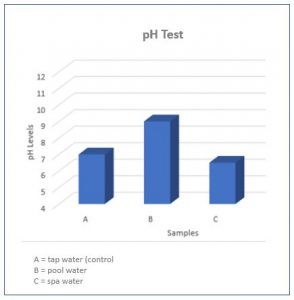It’s not uncommon to accidentally swallow some water when you are swimming in a pool. Public pools are carefully monitored and treated with chlorine to prevent bacteria and other contaminants. While we wouldn’t recommend drinking pool water on a regular basis, we were curious about what’s in our pool water.

In an emergency situation, would it be safe to drink pool water? We decided to compare pool water, spa water, and tap water using TestAssured’s 4 Test Kit Set for Schools and Science Fairs. This set includes 4 test kits and can be used by school students in third grade and above to complete a variety of science projects like this one.
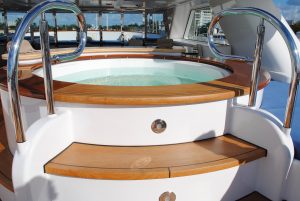
Supplies
The first thing you need to do is gather your supplies:
- Test Assured 4 Test Kit Set with TD Meter
- Zipper sandwich bags
- Paper towels
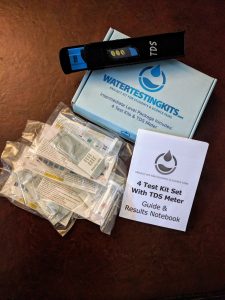
Preparation
To prepare for the tests, you’ll need to gather your water samples. We tested water from our local pool, a hot tub, and tap water for the control. We found that one of the easiest ways to collect outside water samples is to use zipper sandwich bags. You can easily label the bags, and they are large enough to allow for the TDS test. For more stability (and less chance of spills) you can put the baggies inside mugs or cups.
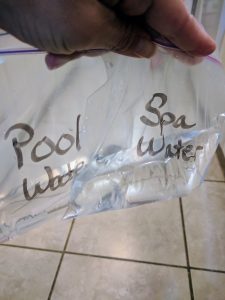
Now is a good time to label your vials and write your water sources in the results notebook.
Testing
The first test you want to start with is for total dissolved solids, using the TDS meter. The meter will not fit in the test vials, so it is easier to complete this part of the experiment while your samples are still in the baggies. To perform the TDS test, simply turn on the meter and submerge the prongs in the samples. Rinse the meter with clean water between each test. Record your results in the results notebook.
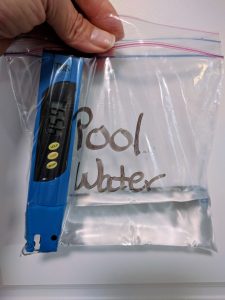
After completing the TDS test, you will need to pour your samples into the vials you labeled. To transfer your samples to the vials, simply snip off a small corner of the baggie to create a spout. Fill each vial to within a ¼” of the top. Be sure to wipe up any spills, so you don’t contaminate the test strips.
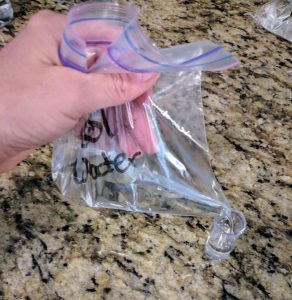
Before you get started with the tests, now is a good time to make some visual observations. Take notes about how clear or cloudy your samples look. Are there any visible particles floating in any of the samples? These observations can be written in the “Notes” on the last page of the results notebook.
Now you’re ready to get started with the rest of the tests. It’s easiest to work with one sample at a time. Follow these instructions to complete the remaining tests.
Alkalinity/pH/Hardness Test
- Remove the test strip from the packet labeled, “ALK/pH/Hard”
- Pick up the strip on the end with no pads
- Dip the strip in the sample for one second and remove
- Hold the test strip level and wait 10 seconds
- Place the strip as shown in the picture and compare to the color chart for alkalinity, pH, and hardness
- Record your results in the results notebook
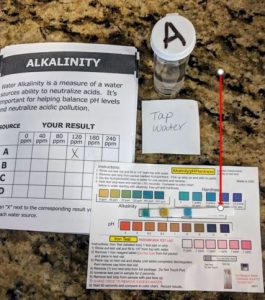
Total Chlorine/Copper/Nitrate/Nitrite Test
- Remove the test strip from the packet labeled, “CL/CO/NA/NI”
- Pick up the strip on the end with no pads
- Dip the strip in the sample three times and remove – DO NOT SHAKE OFF EXCESS WATER
- Hold the test strip level for 2 seconds
- Place the strip as shown in the picture and compare to the color chart for chlorine and copper
- Wait 45 seconds before reading the results for nitrate and nitrite
- Record your results in the results notebook
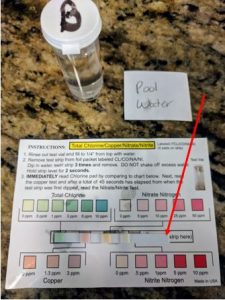
Iron Test (Complete this test last)
- Remove one iron reagent tablet from the foil packet and place in test vial (the reagent could alter the results of other tests which is why the iron test is completed last)
- Place the cap on the test vial and shake for approximately one minute, until the tablet is completely dissolved
- Remove the test strip from the packet labeled, “Iron Test”
- Dip the strip in the sample for 2 seconds
- Shake the strip once and wait 60 seconds
- Place the strip as shown in the picture and compare to the color chart for iron
- Record your results in the results notebook
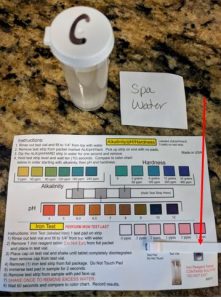
Repeat all three tests for each of your samples.
Results
Now that you have completed each of the tests on your four samples, it’s time to look at your results. Ask yourself these questions:
- Did the pool water or the spa water contain less contamination?
- Which sample contained the most chlorine?
- Would it be ok to drink pool water or spa water in an emergency?
- What results did you find the most surprising?
Record your answers on the “Notes” page. You can use clear tape to fix the test sticks to the color charts to display your results for your science fair project. You may even want to create some graphs or charts from your results.
